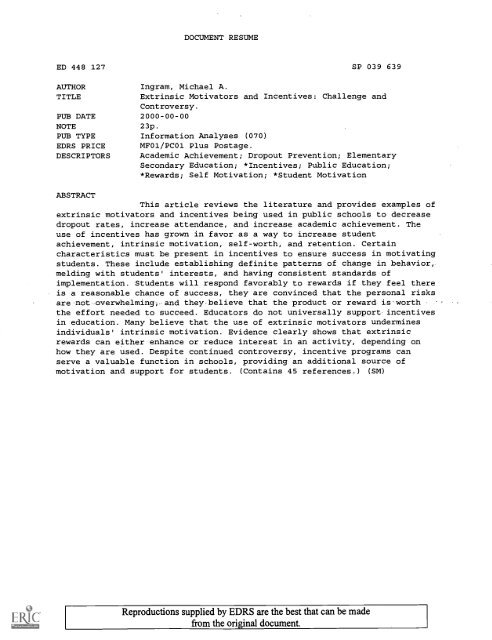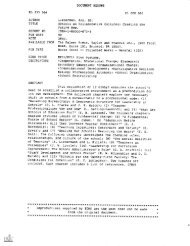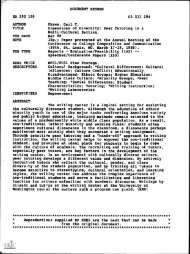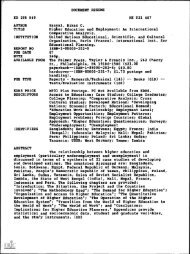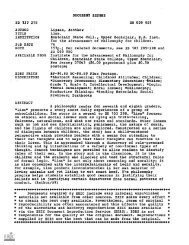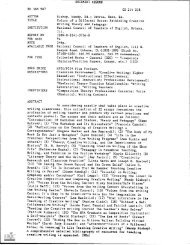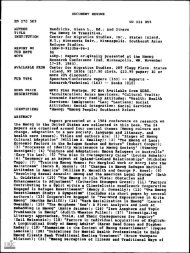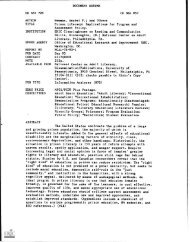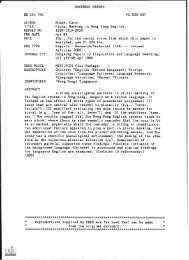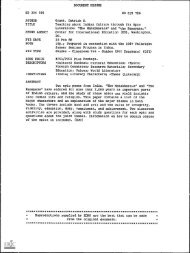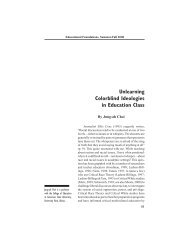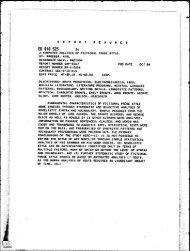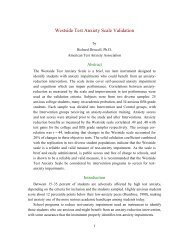Extrinsic Motivators and Incentives: Challenge and Controversy.
Extrinsic Motivators and Incentives: Challenge and Controversy.
Extrinsic Motivators and Incentives: Challenge and Controversy.
Create successful ePaper yourself
Turn your PDF publications into a flip-book with our unique Google optimized e-Paper software.
DOCUMENT RESUMEED 448 127 SP 039 639AUTHOR Ingram, Michael A.TITLE<strong>Extrinsic</strong> <strong>Motivators</strong> <strong>and</strong> <strong>Incentives</strong>: <strong>Challenge</strong> <strong>and</strong><strong>Controversy</strong>.PUB DATE 2000-00-00NOTE 23p.PUB TYPE Information Analyses (070)EDRS PRICEDESCRIPTORSMF01/PC01 Plus Postage.Academic Achievement; Dropout Prevention; ElementarySecondary Education; *<strong>Incentives</strong>; Public Education;*Rewards; Self Motivation; *Student MotivationABSTRACTThis article reviews the literature <strong>and</strong> provides examples ofextrinsic motivators <strong>and</strong> incentives being used in public schools to decreasedropout rates, increase attendance, <strong>and</strong> increase academic achievement. Theuse of incentives has grown in favor as a way to increase studentachievement, intrinsic motivation, self-worth, <strong>and</strong> retention. Certaincharacteristics must be present in incentives to ensure success in motivatingstudents. These include establishing definite patterns of change in behavior,melding with students' interests, <strong>and</strong> having consistent st<strong>and</strong>ards ofimplementation. Students will respond favorably to rewards if they feel thereis a reasonable chance of success, they are convinced that the personal risksare not -overwhelmingi <strong>and</strong> they believe that the product or reward is-worththe effort needed to succeed. Educators do not universally support incentivesin education. Many believe that the use of extrinsic motivators underminesindividuals' intrinsic motivation. Evidence clearly shows that extrinsicrewards can either enhance or reduce interest in an activity, depending onhow they are used. Despite continued controversy, incentive programs canserve a valuable function in schools, providing an additional source ofmotivation <strong>and</strong> support for students. (Contains 45 references.) (SM)Reproductions supplied by EDRS are the best that can be madefrom the original document.
Alcohol Policy in EuropeChapter 3. Does alcohol policy make any difference?This chapter covers how the scales were structured, filled in <strong>and</strong> put into use. Some of thebuilt-in weaknesses of the methodology are discussed, <strong>and</strong> the correlation between alcoholconsumption <strong>and</strong> the strictness of policies is analyzed.What we didThe AMPHORA scale consists of a four-page questionnaire on formal alcohol policies. There areover 50 questions - most of them are answered by ticking boxes, but open answers are alsoincluded. The questionnaire is divided into seven subcategories, dealing with different aspectsof alcohol policies. The subcategories have been given weights, <strong>and</strong> questions within eachsubcategory generate points. All questions do not receive points, as some are used forcollecting contextual information on the alcohol situation.In the scale constructed in the Bridging the Gap project, a panel of experts were asked to givetheir verdict on the effectiveness of different alcohol policy measures included in the scale. Inthe AMPHORA scale, however, the weights were adjusted <strong>and</strong> validated by referring to state ofthe art research on evidence-based practice (WHO Regional Office for Europe 2009; Babor etal. 2010). As physical <strong>and</strong> economic availability are the most powerful tools in controllingalcohol consumption, each of them contributes 25% of the total maximum scores. Age limits,drink driving <strong>and</strong> alcohol advertising controls are each rewarded with a share of 15% of themaximum score, while public policy’s share of the total score is a mere 5%. The firstsubcategory in the scale, i.e. “Starting points” is a general, descriptive category, which givesthe possibility to specify how alcoholic beverages are defined in the country in question, <strong>and</strong>offers the opportunity to give a brief description on how alcohol is regulated by law in thecountry. One can, for instance, state that there is a specific Alcohol Act in force, or indicatethat alcohol is regulated mainly through other, non-alcohol specific, legislations. Subcategoryone is mainly for information gathering purposes, <strong>and</strong> it does not generate any numeric score,unlike the other subcategories in the scale.The 33 forms were filled in using data collected by the WHO-EURO in the European Survey onAlcohol <strong>and</strong> Health, corresponding to the year 2010. In addition, we contacted experts in thecountries in order to get more contextual information.Table 1. Subcategories of alcohol policy measuresSubcategory of alcohol policy measures %I Starting points 0 0MaxpointsII Control of production, retail sale <strong>and</strong> distribution of alcoholic beverages 25 40III Age limits <strong>and</strong> personal control 15 24IV Control of drunk driving 15 24V Control of advertising, marketing <strong>and</strong> sponsorship of alcoholic beverages 15 24VI Public policy 5 8VII Alcohol taxation <strong>and</strong> price 25 40Total 100 160
<strong>Extrinsic</strong> <strong>Motivators</strong> 2As teachers look for new <strong>and</strong> interesting ways to keeptheir students' attention,they have increasingly resortedto the use of extrinsic motivators <strong>and</strong> incentives. Yet, theutilization of these methods are quite controversial. Thisarticle is designed to review the literature <strong>and</strong> provideexamples of extrinsic motivators <strong>and</strong> incentives being usedin public schools to decrease dropout rates, increaseattendance <strong>and</strong> raise academic achievement scores.3
other people" (p. 950).<strong>Extrinsic</strong> <strong>Motivators</strong> 4As stated earlier, educationaltheorists primarily concern themselves with the intrinsicmotivation construct, perhapsrationalizing that internalmotivation is what causes a person to behave <strong>and</strong> perform ina certain way (Calder & Staw, 1975; Gottfried, 1985;Husman& Lens, 1999) Jordan, 1986;Pittman, 1998; Reeve,Cole & Olson, 1986; Weiner & M<strong>and</strong>er, 1978).Bower (1994) stated that behavioral <strong>and</strong> cognitiveresearchers are divided on issue of whether externalrewards affect motivation <strong>and</strong> creativity.Behavioral researchers argue that external rewards,such as cash incentives,can increase performance at work<strong>and</strong> school; cognitive researchers contend the opposite,noting that extrinsic rewardslead to a dependence onacceptance, reinforcement <strong>and</strong> approval from others (Bower,1994, p. 405).The divergent views held about intrinsic <strong>and</strong> extrinsicmotivation (Kohn, 1996;Lepper, 1981; Nelson, 1996; Reid,Bailey-Dempsey, Cain, Cook & Burchard, 1594; Schaps &Lewis, 1991) led Cameron <strong>and</strong> Pierce (1994) to examine theeffects of reinforcement/rewards on intrinsic motivation.The main meta-analysis incIuded"96 eXperimental studiesusing between-groups designs: in which rewarded subjectst46fe compared with nonrewarded controls on four measures ofintrinsic motivation.The researchers found that rewardssuch as verbal praise do not decrease intrinsic motivation,
<strong>Extrinsic</strong> <strong>Motivators</strong> 5but that expectations for automatic tangible rewards forcompleting a task do. The researchers concluded that whena reward is removed after the end of a measured task,theremoval had a minimal negative effect on intrinsicmotivation.Five studies using within-subject designs werealso conducted to evaluate the effects of the reinforcementon intrinsic motivation.The results of this secondanalysis revealed that reinforcement does not derailindividuals' intrinsic motivation.Although theconclusions drawn by Cameron <strong>and</strong> Pierce's meta-analysisproved controversial <strong>and</strong> were the subject of much debate(Cameron & Pierce, 1996; Lepper, Reavney & Drake, 1996;Ryan & Deci, 1996), the investigation did provide evidencethat intrinsic motivation is not negatively effected byexternal rewards.The researchers also considered the theoretical<strong>and</strong>practical implications of the meta-analysis. The resultsof the meta-analysis examination suggested the need tochange the current ideasabout the ways in which motivationcan be used. In other words, we need to ab<strong>and</strong>on old notionsabout the negative effedts of external rewardreinforcements <strong>and</strong> adopt new views that embrace the ideathat intrinsic <strong>and</strong> extrinsic motivational factors can worktogether.Tie meta-analysis also hinted that intrinsicinterest is enhanced <strong>and</strong> stimulated by such reinforcementsas, verbal praise <strong>and</strong> positive feedback.Further, if
<strong>Extrinsic</strong> <strong>Motivators</strong> 6rewards are used as reinforcements/incentives <strong>and</strong> arecontingent upon performance, such extrinsic incentivesystems can be implemented effectively in the classroomdespite teacher reservations.INCENTIVESThe use of incentives in public schools has grown infavor as a way to increase student achievement, intrinsicmotivation, self-worth <strong>and</strong> retention rates (Chance, 1993;Covington, 1984; Haslinger, Kelly & O'Lare, 1996; Kusky,1994; Lubell, 1991; Martin, 1991; Purvis, Garvey &Purvis;19 Shroder, 1994). <strong>Incentives</strong> are defined as. . something that incites or is likely to incitedetermination or action (Marriam Webster Dictionary, 1994,p. 375). Seone <strong>and</strong> Smink (1991) reported that manyelementary school teachers use incentives as an integralpart of their classroom management strategy.C<strong>and</strong>y,parties, special favors <strong>and</strong> privileges are some of the mostcommonly used classroom management incentives.<strong>Incentives</strong>can also be used successfully in high schools to encourageacademic achievement.Such things as monetary rewards,special recognition, gift certificates, scholarshipcompetition, extra field trips, <strong>and</strong> discount tickets arecommonly used to promote academic achievement <strong>and</strong>attendance within high schools (p. 3).While the use of external rewards to spur intrinsicmotivation <strong>and</strong> productivity in classrooms is well
<strong>Extrinsic</strong> <strong>Motivators</strong> 7documented in the literature (Bates, 1979; Bracey, 1994;Roney & Morgan, 1991),educators have become increasinginterested using monetary incentives to motivate studentsto attend school or improve their performance,Reid <strong>and</strong>Dempsey (1995) stated that ". . . the use of monetary orother tangible incentivesto induce children to "be goodstudents . .. probably originated shortly after the firstattempt was made to educate a child. ..Within the pastdecade, various drop-out prevention programs have used theequivalent of financial incentives in the form of . ..college scholarshipsas means to motivate students tograduate from high school (p.331). Two prominent programshave these monetary incentives 'Lang'sI Have A DreamProgram <strong>and</strong> the D-FY-It program in Texas. In the "I Have aDream Program,in New York," Lang donated money to schoolswith the intention of paying for students collegeeducations if they completed high school. His commitmentwas expensive, but effective; the graduation rate at thoseschools stood at <strong>and</strong> in the D-FY-IT (DRUG FREE YOUTH INTEXAS) program in Dallas, Texas incentives were used tohelp curb drug abuse in local schools.Students whocompleted voluntary drug tests received discounts fromlocal businesses, as well as the possibility of financialassistance with college. The program sponsors believedthose students drawn by merch<strong>and</strong>ise discounts <strong>and</strong> help withcollege, might persuade others to stayaway from drugs.
<strong>Extrinsic</strong> <strong>Motivators</strong> 8Further, the threat of testing might help students fend offpeer pressure to use drugs (Gest, 1996, p. 62). The SayYes to Education Program, offered the promise of fully paidcollege tuition for college education or vocationaltraining to 112 sixthgrade students from low incomefamilies in the School District of Philadelphia.Theprogram's aim was to change . . . the . . . odds thatdefeat inner-city students (Newburg & Sims, 1996, p. 149).While the uses of incentives vary, they have one commongoal: to motivate, excite <strong>and</strong> drive people to action.Their success in other areas has prompted educatorsto ask,"How can incentives be utilized most effectively within thethe school setting?"(Seone <strong>and</strong> Smink, 1991, p. 2)Early studies of token systems were conducted toascertain the effectiveness of external incentives orrewards in the classroom setting (Ayllon & Azrin, 1968;Ford & Foster, 1976; Levine & Fasnacht, 1974; Ristner,Hammer, Wolfe, Rothblum & Drabman, 1982).Razdin (1977) noted that tokens such as tickets, stars,points on a tally sheet, <strong>and</strong> currency or coins were used ascontingencies to modify,reinforce or change behavior (p.47). While the research suggested that students were oftenmotivated toward better academic <strong>and</strong> behavioralperformances with the introduction of tokens into theclassroom environment (Bedell & Archer, 1980) grades werestill the most common motivators in most schools.In fact,
<strong>Extrinsic</strong> <strong>Motivators</strong> 9Deutsch, (1979,) described grades as being " . . . thebasic currency of our educational system."(p. 393).Teachers assign grades, <strong>and</strong> commented on students'quizzes, tests, <strong>and</strong> major assignments.They also givespecial recognition or awards to students who do well orimprove their performance.Although feedback, evaluation<strong>and</strong> recognition practices are supposed to motivate studentsto attain better grades, these measures are largelyineffective, as measured by the number of students who arenot performing up to potential (MacIver & Reuman,1993;1994, p. 24).Traditional feedback, grading, <strong>and</strong> recognitionpractices in schools are based on evaluation systems whichcompare one student's performance to other students, or todesirable st<strong>and</strong>ards of achievement.The implicit goal isfor students to attain higher grades, <strong>and</strong> recognition, suchas honor roll membership that accompany such grades(MacIver, 1992, p.8).Academically disadvantaged studentsat the middle school level who lag significantly behindmore advantaged classmates in academic skills may find itimpossible to attain this implicit goal even with hardwork.Neither will dramatic progress guarantee asuccessful outcome.Disadvantaged students may still staynear the bottom of their class, far from the absolutelevels of performance that are rewarded <strong>and</strong> recognized intheir schools.When students realize that there best10
<strong>Extrinsic</strong> <strong>Motivators</strong> 10efforts will go unrecognized <strong>and</strong> un-rewarded, they becomefrustrated, <strong>and</strong> disengaged from school (Natriello, 1982).As a consequence, levels of effort <strong>and</strong> rates of progressdrop precipitously.Bishop (1989) <strong>and</strong> Chance(1993) both suggested adopting the stance that externalreinforcers such as; monetary incentives enhance academicachievement <strong>and</strong> motivation.They argued that externalmotivators such as incentives assist students in learningthe value of supply-side economics.Bishop (1989) notedthat ". . .only with an effective system of rewards withinthe schools . . . can we hope to overcome the pervasiveapathy in American high schools <strong>and</strong> achieve excellence(p.42).Seone <strong>and</strong> Smink(1991) conducted an analysis of thedifferent types of incentives offered to students, <strong>and</strong>grouped them into four categories: Education completion,academic achievement, attendance <strong>and</strong> personal improvement.1) Education Completion <strong>Incentives</strong> - These types ofincentives encourage students to complete school inorder to pursue higher education or join the workforce.The following incentivea are commonly used.A) Businesses promise to pay the expenses ofcollege <strong>and</strong> becoTe involved with studentswhile they are in school.B) Schools establish Buddy systemC) Businesses offer employment for graduating11
<strong>Extrinsic</strong> <strong>Motivators</strong> 112) Academic Achievement <strong>Incentives</strong> - Academicachievement incentives motivate students to improveor maintain academic performance.A) Schools award goal cards straight A'performanceHolders of goal cards receive reducedprices on items from local businesses.B) Students earn a certain amount of moneyfor each high grade (this money is placedin a college fund).3) Attendance <strong>Incentives</strong> - <strong>Incentives</strong> aimed atimproving attendance are important because excessiveabsences can adversely affect students' achievementlevels, <strong>and</strong> their motivation to stay in school.A) Students earn prizes based on the number ofdays they are in school. (i.e., food, t-shirts, hats, mugs, etc),B) If students miss no more than one day, theycan earnT.V sets, cash <strong>and</strong> walkmans.4) Personal ImpttiveMent <strong>Incentives</strong> - Personalfactors, such as teenage pregnancies <strong>and</strong> unstablehome environments, also impact academic achievement<strong>and</strong> attendance.Some schools are incorporatingimproved <strong>and</strong> extended support services to deal withnonschool related factors affecting students'motivation <strong>and</strong> performance.12
<strong>Extrinsic</strong> <strong>Motivators</strong> 12A) Students acquire points when they use theservices of local agencies, such ashealth centers.As the pointsaccumulate, students can win prizes(fast-food gift certificates )B) Schools provide cash awards ormerch<strong>and</strong>ise for attendance <strong>and</strong> positivebehavior.C) Businesses guarantee of summer employmentCHARACTERISTICS OF INCENTIVESIn analyzing the incentives presently used to motivatestudents to complete their education, one notices thatcertain characteristics must be present to ensure success.Deustch (1979) noted that incentivescan be effective if;1) They establish definite patterns of changes inbehavior,2) They meld with the interests of the students,3) They can be attained by most students.4) They have consistent st<strong>and</strong>ards of implementation.5-) Students underst<strong>and</strong> what to do to attain6) Recognition is given only to those receivingawards, <strong>and</strong>7) Varying levels <strong>and</strong> types of incentives are offeredfor different levels of achievement (p. 393).13
<strong>Extrinsic</strong> <strong>Motivators</strong> 13Further, in line with the expectancy theory,a studentwill respond favorably to a reward under the followingcircumstances:a. The pupil feels that there is a reasonable chanceof success.b. The pupil is convinced that the personal risks arenot overwhelming(presiding in front of a largegroup, for example, may be numbing).c. The pupil believes that the product or reward isworth the effort needed to succeed (enormouspersonal efforts followed by meager rewardshave little appeal) (Barnes, 1988, p.12).The characteristics of incentives suggest that it isimportant to provide students with avenues for success <strong>and</strong>recognition.These reinforcers along with verbalreinforcers, such as praise <strong>and</strong> encouragement willincreaseopportunities for students to achieve academically.CONTROVERSYEducators do not universally support incentivesacademic settings.Many educational theorists believe thatthe use of extrinsic motivators, in particular, underminesinindividuals' intrinsic motivation (Bernstein, 1980;Covington, 2000; Deci, Nezlek & Sheinman, 1981;Erez,Gopher & Arzi, 1990; Lepper & Hodell, 1989; Kohn, 1993;Morgan, 1984; Ryan & Deci, 2000).Lepper <strong>and</strong> Hodell(1989) argued that when rewards are14
<strong>Extrinsic</strong> <strong>Motivators</strong> 15Rewards reduce motivation when given without regard toperformance, or when the performance st<strong>and</strong>ard is so highthat students cannot reach it.When students show a highrate of success that is rewarded, the rewards do not havenegative effects.The evidence, clearly shows thatextrinsic rewards can go both ways: they can either enhanceor reduce interest in an activity, depending on how theyare used (p. 43).The three types of rewards he studiedfollow:1) Task-contingent rewards - available for merelyparticipating, without regard to any st<strong>and</strong>ard ofperformance.There is usually a decline ininterest when activity is rewarded.2) Performance-contingent rewards - available onlywhen students achieve a certain st<strong>and</strong>ard.Sometimes these produce negative results.3) Success-contingent rewards - are given for goodperformance <strong>and</strong> reflect either success in a goal orprogress toward one.These rewards do not havenegative effects; in fact, they typically increaseinterest in the rewarded activity.Shanker (1980) stated that he believed that incentivesget people started <strong>and</strong> that our economic system operateswith a variety of incentives. He stated that ". . . mostadults go to work regularly <strong>and</strong> on time because of anelaborate system of incentives that are as external to16
<strong>Extrinsic</strong> <strong>Motivators</strong> 16their work as cokes <strong>and</strong> hamburgers are to schoolattendance" (p.E7).Finally, Morgan (1997) in a review of Kohn's (1993)book, "Punished by Rewards: The Trouble with Gold Stars,Incentive Plans <strong>and</strong>, A's,Praise <strong>and</strong> other Bribes" arguedthat reinforcers are frequently situation <strong>and</strong> personspecific.By situation specific, Morgan means that awards orreinforcers are givenas a result of an event task.Person-specific, on the other h<strong>and</strong>, means that awards aregiven to chosen individualsfor events or completed tasks.Therefore, his central point is that intrinsic motivationdoes not decrease, because reinforcers are not given acrossthe board.Despite the continued controversy, incentive programscan serve a valuable function in schools.They provide anadditional source of motivation <strong>and</strong> support for students.School personnel, <strong>and</strong> in particular, school counselorsacknowledge that incentive programs provide a means ofdeveloping students' academic emotional <strong>and</strong> social growth.This perspective is deemed crucial in today's ever changing<strong>and</strong> highly diverse society.17
<strong>Extrinsic</strong> <strong>Motivators</strong> 17ReferencesAmabile, T.M., Hill, K. G., Hennessey,B.A., & Tighe,E.M. (1995). The work preference inventory: Assessingintrinsic <strong>and</strong> extrinsic motivational orientations.Journalof Personality <strong>and</strong> Social Psychology,66 (50), 950-967.Ayllon, T., & Azrin, N. (1968). The token economy: Amotivational system for therapy <strong>and</strong> rehabilitation.York:Appleton-Century Crofts.NewBarnes, D.L. (1988). The use of incentives <strong>and</strong> rewardsin elementary classrooms. The Teacher Educator, 23, 11-16.Bishop, J.H. (1989). Motivating students to study:Expectation, rewards, achievement. NASSP Bulletin, 123,27-38.Bower, B. (1994). Rewards surface as creativityenhancers. Science News, 145 (26), 405.Bracey, G. (1994). Reward <strong>and</strong> punishment. Phi DeltaKappan, 75 (6), 494-495.Brennan, T.P., & Glover, J.A. (1980). An examinationof the effects of extrinsic reinforcers on intrinsicallymotivated behavior: experimental <strong>and</strong> theoretical.Behavior <strong>and</strong> Personality, 8, 27-32.SocialBrophy, J. (1987). Synthesis of research onstrategies for motivating students to learn.Leadership, 45(2), 40-48.Educational18
<strong>Extrinsic</strong> <strong>Motivators</strong> 18Calder, B, & Staw, B. (1975). Self-perception ofintrinsic <strong>and</strong> extrinsic motivation.Journal of Personality<strong>and</strong> Social Psychology, 31, 599-605.Cameron, J., & Pierce, W.D. (1994). Reinforcement,reward, <strong>and</strong> intrinsic motivation: A meta-analysis.Reviewof Educational Research, 64, 363-423.Chance, P. (1993). The hidden treasures of extrinsicrewards. Education Digest, 58 (9), 42-46.Covington, M. (1984). The self-worth theory ofachievement motivation:Findings <strong>and</strong> implications.The Elementary School Journal, 85 (1), 5-20.Covington, M V. (2000). Intrinsic versus extrinsicmotivation in schools: A reconciliation.CurrentDirections in Psychological Science, 9(1), 22-25.Deutsch, M. (1979). Education <strong>and</strong> distributivejustice. American Psychologist, 34, 393.Erez, M., Gopher, D., & Arzi, N. (1990). Effects ofgoal difficulty, self-set goals, <strong>and</strong> monetary rewards ondual task performance.Organizational Behavior <strong>and</strong> HumanDecision Processes, 47, 247-269.Ford, J., & Foster, S.L. (1976). <strong>Extrinsic</strong> incentives<strong>and</strong> token-based programs. American Psychologist, 31, 87-90.19
<strong>Extrinsic</strong> <strong>Motivators</strong> 19Hawkins, D. (1995). Johnny can read for cash <strong>and</strong>freebies. U.S. News & World Report, 119 (17), 73.Hodgkinson, H. (1985). All one system: Demographicsof education, kindergarten through graduate school.Washington, D.C.:Institute for Educational Leadership.Holt, M. (1987). Excellence is intrinsic.The Clearing House, 60 (9), 418-419.Husman,J., & Lens, W. (1999). The role of the futurein student motivation. Educational Psychologist. 34(2),113-125.Kazdin, A.E. (1977). The token economy. New York:Plenum Press.Kohn, A. (1993). Punished by rewards. Boston:Houghton Miflin.Kohn, A. (1996). By all available means: Cameron <strong>and</strong>Pierce's defense of extrinsic motivators.Review ofEducational Research, 66, 1-4.Knell, S. E. (1999). Assessing a second-gradestudent's motivation to read: Examining extrinsic <strong>and</strong>intrinsic motivators, teacher, parents, <strong>and</strong> studentattitudes, the classroom environment, <strong>and</strong> the role oftechnology in reading motivation.Dissertation AbstractsInternational, 60(6-A).20
<strong>Extrinsic</strong> <strong>Motivators</strong> 20Kusky,Jr., C.S. (1994). Catch them doing somethinggood. Phi Delta Kappan, 75 (6), 502.Lepper, M. R., & Hodell, M. (1989). Intrinsicmotivation in the classroom.In C. Ames <strong>and</strong> R. Ames(Eds.), Research on motivation <strong>and</strong> education, Goals <strong>and</strong>Cognitions. San Diego, CA: Academic.Lepper, M.R., Keavney, M., & Drake, M. (1996).Intrinsic motivation <strong>and</strong> extrinsic rewards:A commentaryon Cameron's <strong>and</strong> Pierce's meta-analysis.Review ofEducational Research, 66(1), 5-32.Martin, L. (1991). Improving student attendance withrecognition, rewards. NASSP Bulletin, 75 , 111-112.Maclver, D.J., & Reuman, D. (1993/1994). Giving theirbest. American Educator, 24-31.Martin, L. (1991). Improving student attendance withrecognition, rewards.NASSP Bulletin111-112.Morgan, D.L. (1997). Rewards <strong>and</strong> punishments, ends <strong>and</strong>means. Journal of Teacher Education, 48 (2), 150-154.Morgan, M. (1984). Reward-induced decrements <strong>and</strong>increments in intrinsic motivation.Review of EducationalResearch, 54 (1), 5-30.Natriello, G. (1982). Organizational evaluationsystems <strong>and</strong> student disengagement in secondary schools.Final report to the National Institute of Education.St.Louis, MO: Washington University.
<strong>Extrinsic</strong> <strong>Motivators</strong> 21Nelson, B. (1996). Dump the cash, load on the praise.Personnel Journal, 75 (7), 65-70.Newburg, N. A., & Sims, R. (1996). Context thatpromotes success for inner city students.Urban Education,31 (2), 149-176.Pittman, T.S. (1998). Motivation. In Gilbert, D. T.,& Fiske, S.T. (Eds). The h<strong>and</strong>book of social psychology,Vol. 1 (4th ed.). (pp. 549-590). Boston, MA, US: Mcgraw-Hill. xx, 865 pp.Reid, W.J., & Bailey-Dempsey, (1995). The effects ofmonetary incentives on school performance.The Journal ofContemporary Human Services, 76 (6), 331-340.Ryan, M., & Deci, E. L. (2000). Intrinsic <strong>and</strong>extrinsic motivations: Classic definitions <strong>and</strong> newdirections. Contemporary Educational Psychology. 25(1),54-67.Ryan, R.M. & Deci, E.L. (1996). When paradigms clash:Comments on Cameron <strong>and</strong> Pierce's claim that rewards do notundermine intrinsic motivation.Review of EducationalResearch, 66, 33-38.Schaps. E., & Lewis, C. (1991). EducationalLeadership, 48(7), 81-83.22
<strong>Extrinsic</strong> <strong>Motivators</strong> 22Seone, M., & Smink, J. (1991). <strong>Incentives</strong> <strong>and</strong>education: A series of solution <strong>and</strong> Strategies .Number 4, NationalDropout Prevention Center: Clemson.Shanker, A. (1990, April 8). <strong>Incentives</strong> forattendance. The New York Times, p. E7Weintraub, A. (1994, August 1). Newmaker Q & A: NewTaft principal aims to improve attendance.Enquirer, p. A6.The CincinnatiWeirsma, U. (1992). The effects of extrinsic rewardson intrinsic motivation: A meta-analysis. Journal ofOccupational <strong>and</strong> Organizational Psychology,65, 101-114.Wirth, A. G. ( 1993). Education <strong>and</strong> work: Thechoices we face. Phi Delta Kappan, 74 (5), 361-366.
U.S. Department of EducationOffice of Educational Research <strong>and</strong> Improvement (OERI)National Library of Education (NLE)Educational Resources Information Center (ERIC)REPRODUCTION RELEASEERICI. DOCUMENT IDENTIFICATION (Class of Documents):All Publications:eXATCTSCSeries (Identify Series):Division/Department Publications (Specify):Publication Date:II. REPRODUCTION RELEASE:In order to disseminate as widely as possible timely <strong>and</strong> significant materials of interest to the educational community, documents announced in themonthly abstract journal of the ERIC system, Resources in Education (RIE), are usually made available to users in microfiche, reproduced paper copy,<strong>and</strong> electronic media, <strong>and</strong> sold through the ERIC Document Reproduction Service (EDRS). Credit is given to the source of each document, <strong>and</strong>, ifreproduction release is granted, one of the following notices is affixed to each document.If permission is granted to reproduce <strong>and</strong> disseminate the identified documents, please CHECK ONE of the following three options <strong>and</strong> sign at thebottom of the page.The sample sticker shown below will beaffixed to all Level 1 documentsPERMISSION TO REPRODUCE ANDDISSEMINATE THIS MATERIAL HASBEEN GRANTED BY\eTO THE EDUCATIONAL RESOURCESINFORMATION CENTER (ERIC)The sample sticker shown below will beaffixed to all Level 2A documentsPERMISSION TO REPRODUCE ANDDISSEMINATE THIS MATERIAL INMICROFICHE, AND IN ELECTRONIC MEDIAFOR ERIC COLLECTION SUBSCRIBERS ONLY,HAS BEEN GRANTED BY\eSaTO THE EDUCATIONAL RESOURCESINFORMATION CENTER (ERIC)The sample sticker shown below will beaffixed to all Level 28 documentsPERMISSION TO REPRODUCE ANDDISSEMINATE THIS MATERIAL INMICROFICHE ONLY HAS BEEN GRANTED BYTO THE EDUCATIONAL RESOURCESINFORMATION CENTER (ERIC)Level 12ALevel 2A2BLevel 2BCheck here for Level 1 release, permitting reproduction<strong>and</strong> dissemination In microfiche or other ERIC archivalmedia (e.g., electronic) <strong>and</strong> paper copy.Check here for Level 2A release, permitting reproduction<strong>and</strong> dissemination In microfiche <strong>and</strong> In electronic mediafor ERIC archival collection subscribers onlyCheck here for Level 2B release, permittingreproduction <strong>and</strong> dissemination in microfiche onlyDocuments will be processed as indicated provided reproduction quality permits.If permission to reproduce Is granted, but no box is checked, documents will be processed at Level 1.I hereby grant to the Educational Resources Information Center (ERIC) nonexclusive permission to reproduce <strong>and</strong> disseminate these documentsas indicated above. Reproduction from the ERIC microfiche or electronic media by persons other than ERIC employees <strong>and</strong> its systemcontractors requires permission from the copyright holder. Exception is made for non-profit reproduction by libraries <strong>and</strong> other service agenciesto satisfy information needs of educators in response to discrete inquiries.Signhere,-)please)rgantratibNAddress:breidAJ 4 :7-AJ6-a_twv.,S4-47 Un'r uelPrinterkNameiPos' ale:011-_Zrz3 7-3 croFlu's-v/437-019w.Ebt11(,1=4.1jorol.e1, Date- TI3P e);)(over)
III. DOCUMENT AVAILABILITY INFORMATION (FROM NON-ERIC SOURCE):If permission to reproduce is not granted to ERIC, or, if you wish ERIC to cite the availability of these documents from anothersource, please provide the following information regarding the availability of these documents. (ERIC will not announce a documentunless it is publicly available, <strong>and</strong> a dependable source can be specified. Contributors should also be aware that ERIC selectioncriteria are significantly more stringent for documents that cannot be made available throughEDRS.)Publisher/Distributor:Address:Price:IV. REFERRAL OF ERIC TO COPYRIGHT/REPRODUCTION RIGHTS HOLDER:If the right to grant this reproduction release is held by someone other than the addressee, please provide the appropriate name <strong>and</strong>address:Name:Address:V. WHERE TO SEND THIS FORM:Send this form to the following ERIC Cie:However, if solicited by the ERIC Facility, or if making an unsolicited contribution to ERIC, return this form (<strong>and</strong> the documents beingcontributed) to:ERIC Processing <strong>and</strong> Reference Facility1100 West Street, rd FloorLaurel, Maryl<strong>and</strong> 20707-3598EFF-087 (Rev. 9/97)PREVIOUS VERSIONS OF THIS FORM ARE OBSOLETE.Telephone: 301-497-4080Toll Free: 800-799-3742FAX: 301-953-0263e-mail: ericfac@ineted.govWWW: http://ericfac.piccard.csc.com


